3 DevRel Approaches to Product, Support, and Security
 Francisco Fisher
Francisco Fisher
Just how valuable is a platform or outlet where developers can collaborate, contribute code and give feedback? For one you could consider how many billions Microsoft purchased GitHub for. But that’s only one story among many, and folks in our community have their own examples of how developer relations can make a major impact on a company’s growth.
We’ve hosted a number of experts at panels and on podcasts for discussions about fostering developer communities and the impact that came from encouraging collaboration or paying attention to user behaviors and responding to them.
Building a Community-Driven Product
As is often the case with developer tools, a product’s users and its community are pretty much one and the same. For Nylas CTO and co-founder Christine Spang, her email APIs are used by developers, so being able to observe and react to their behavior is critical.
“It’s very interesting to see what people build with the platform and to get feedback from them,” she says. “We also rely on the community for figuring out what to build next and for getting new ideas as like what people might find useful.”
To me the pinnacle of community involvement is folks that are building things on top of a platform.
To bring the dollar signs back into the equation, Spang notes that by building community early, there is a better chance for profits later on. “If developers weren’t using the platform, then they wouldn’t eventually start companies and and ship products and then actually start paying us for the infrastructure,” she says. “So community is where it starts.”
Keeping an eye on adoption or usage within your developer community can influence the way a product is built or shipped, as is the case with Kyle Wild, who co-founded Keen IO. Wild explains how monitoring what gets used and what doesn’t gave his company the feedback to deliver a more useful product.
“What API features are they using? What SDKs are they using? What have they tested and not engaged with?” he says. “Always at the end of the day it comes down to actually using the product, so that’s the main driver for us.”
Instead of the whole disconnect between the people who make things and the people who use them, if you’re forced to confront the design shortcut that you took and see it, five or six times affect customers’ lives, you probably won’t take as many shortcuts.
Hear more from both Sprang and Wild in this Heavybit panel, Product as Community.

An Organic Support Ecosystem
Devtool companies know the importance of having updated docs in order to support their users with the answers or guidance they need. But what happens when documentation becomes a two-way conversation between the product and developers? Take Contentful’s community site as a prime example.
“We wanted to bring everyone together in a single place, where our developers can talk to our users, and our users can talk to each other,” says Andrey Tigay, QA Engineer at Contentful.
Tigay led the creation of the community forum which was initially designed for employees only. It was later rolled out to a few dozen customers before opening to and eventually being powered by the community. This opened the doors for Contentful to have more contact with those using its APIs or SDKs and offered an open venue for others to learn about the most popular topics and processes.
A forum or community as a solution looks very natural in this case. Later on, your community can become an FAQ for new and old users alike, and letting it happen in this organic way can lead to a more effective resource.
Finding Safety In Numbers
As featured in episode 18 of The Secure Developer, the community platform HackerOne aims to close the divide between developers and white hat hackers by opening the conversation of improved security.
With over 200 thousand members, HackerOne works with companies of all kinds to raise money for bug bounties and vulnerability coordination to help their products stay secure. And while HackerOne encourages developers to run tests and make upgrades to their existing code, they also encourage teams to keep the mindset of secure coding from the outset.
“We would very much encourage and welcome software developers to try out hacking on our platform and hackers who are on our platform to learn about software development, because it just increases their skill,” says HackerOne CEO Marten Mickos.
Some of the best hackers are also developers, so they understand how software is developed and vice versa.
Whether you’re bringing together hackers, developers, users, or a combination of all three, there’s real value in establishing and nurturing your developer relations. Take a look at Heavybit’s community of more than 10,000 global members to see how we can help take your developer product to market.
Subscribe to Heavybit Updates
You don’t have to build on your own. We help you stay ahead with the hottest resources, latest product updates, and top job opportunities from the community. Don’t miss out—subscribe now.
Content from the Library
How It's Tested Ep. #14, Quality Culture with Rosie Sherry of Ministry of Testing
In episode 14 of How It’s Tested, Eden Full Goh speaks with Rosie Sherry, founder of the Ministry of Testing, about her journey...
Authentic Communities in the Era of AI
In this special Speaker Series event, our panel explores the implications of AI on the effort and ability to build authentic...
Jamstack Radio Ep. #124, Complete User Management with James Perkins of Clerk
In episode 124 of Jamstack Radio, Brian speaks with James Perkins of Clerk. Together they explore tools and practices for...